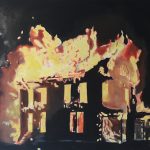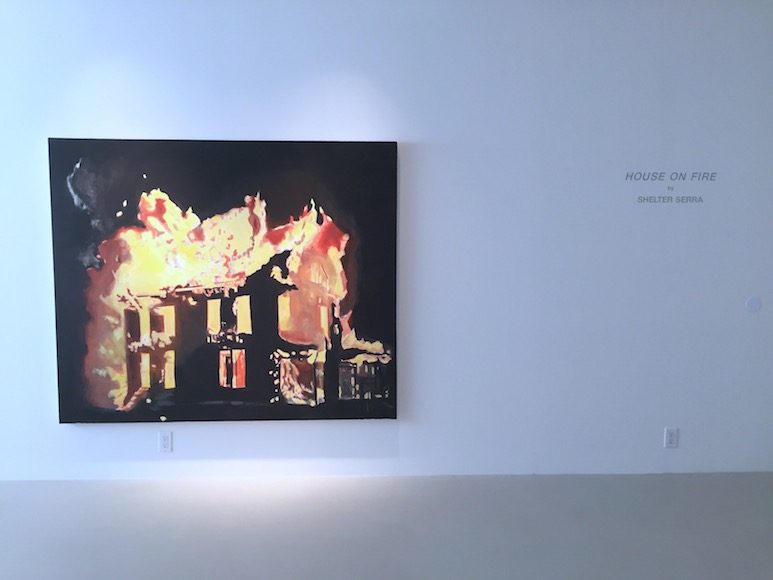by Shana Beth Mason, November 3, 2016
Andy Warhol once said, “I don’t want it to be essentially the same – I want it to be exactly the same. Because the more you look at the same exact thing, the more the meaning goes away, and the better and emptier you feel.” This is a prophetic kind of epithet for the so-called “American Dream”, one that New York-based artist Shelter Serra takes rather seriously. He received his BA in Studio Art from the University of California (Santa Cruz) and an MFA in Painting & Printmaking from the Rhode Island School of Art & Design (RISD), but has developed his artistic practice in a very subdued, renegade fashion. He is a free agent, able to move about seamlessly though variant circles of contemporary art, both high and low. He seems to revel in movement, even though the things he references in his work are highly static and petrified. After what seems like forever, I caught up with Serra before the opening of his solo show House on Fire at Baahng Gallery (New York) on the 27th.
Shelter! How long has it been since we’ve last seen each other? Am I right in saying we met for the first time in 2010 at Primary Projects in Miami?
Hi Shana, It’s has been over a year. Too long! Last I saw you was here in NYC. You are right we did meet officially at Primary. I was doing the Fountainhead residency with the Mikesells, so I was in Miami a few weeks before Art Basel. That was a good year. Andrew Schoultz, Marc Bilj and RETNA were there too.
When I first met you, your work was centered on “shells” or “lost casts” of both luxury and threatening objects like Hummers, Birkin bags, nooses, and/or Rolex watches. Was this the very first stage of your practice, or was there other phases before this?
The first group of work that got shown publicly was the cast pieces. I have always drawn and painted. Before the objects, I was doing installations with grand opening flags and making enlarged Black Amex Cards (2007). To a degree, I have always been interested in the things that surround us daily.
With those works, I sensed that you had captured both the life and death of the object. By “emptying” the object of any sort of monetary value, you sort of distilled each object down to its sign/symbolic presence.
That’s an interesting way of looking at them, I like that. I was thinking about how the casting process stops time and freezes things. Whether it is a trucker’s hat, or a handbag, the moment something loses its immediate referent we see it differently, in a new light so to speak. Some people refer to those works as merely “copies”, or appropriation art, which is a broad way of interpreting the re-presentation of the object. I am more interested in the vessel and its relationship to the tropism of our society. By stripping away the external layers, I hope more is revealed.
Some recent work I’ve seen of yours are super-traditional paintings on canvas. When did these come about? Are they all a part of a congruous series?
I have been working on a specific group of work for the last three to four years. At RISD I studied painting and printmaking, so some things are hard to avoid. The oil paintings are in a sense a way to challenge myself to deal with the unavoidable aspects of image making, i.e. History, implications of the narrative, and memory. I was seeing so much zombie abstraction out there it made me wonder if the commodification of abstract art was fuelling the art bubble. Painting in a more traditional way helped me avoid being trendy. The new paintings are congruent to new sculptures and complement each other in ways that I did not expect. I have a show of the new works opening this month at Baahng Gallery in New York. There will be both sculpture and paintings.
One thing I’ve always liked about you is that you don’t affix ironclad “meanings” or “rumination” from your work. But do you have a baseline interest that has continually existed throughout your career as an artist?
Commodification and the paradox of the American Dream.
Source:
Related:

“SHELTER SERRA SETS THE HOUSE ON FIRE”, by Ashley W. Simpson
Categories: news
Tags: Shelter Serra

